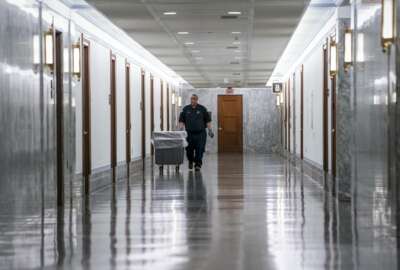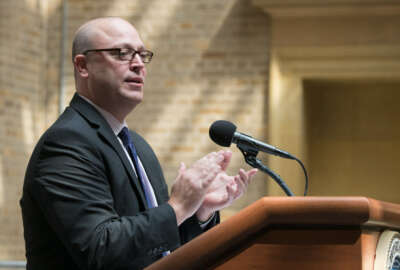
First Look
Here’s how USDA will approach reopening its facilities
Under the Agriculture Department's reopening plan, subcomponent agencies and mission areas should provide masks and face coverings for their employees returning to...
The Agriculture Department has provided some information to its employees about its plans for reopening under three phases.
The reopening playbook, which Federal News Network obtained, describes how USDA employees will gradually return to their offices. The plan is also consistent with the broad reopening guidance the Trump administration offered up last month.
Like the administration’s guidance suggests, reopening timelines will vary within large agencies based on state and local conditions in specific geographic regions.
“Mission areas and agencies will use all available information to make data-driven decisions to reopen a facility,” the reopening summary reads. “Decisions to begin to resume operations will be informed by whether the state or community in which the facility is located has met the federal gating criteria, begun phased reopening, implemented phased reopening of public and commercial activities and lifted mandatory travel and closure restrictions.”
USDA did not respond to multiple requests for comment or additional details about phased reopening timelines at its facilities.
Two USDA employees who work at the department’s headquarters in Washington told Federal News Network they haven’t received a reopening timeline for their facility.
According to the reopening summary, USDA mission areas and agencies should plan to provide face coverings or masks to all onsite employees from phase one through phase three, the department said.
Throughout all three phases, the availability of masks, personal protective equipment and cleaning equipment, as well as the USDA’s ability to meet federal cleaning, health and safety guidelines, will ultimately determine reopening plans for each agency, mission area and department facility.
“Prior to moving to the next phase, a facility must generally operate in the previous phase for at least 14 consecutive days with no new cases of COVID-19 onsite, assess the capacity of local public transportation and status of public schools and day care where applicable and coordinate with the mission area/agency,” the summary reads. “A facility may return to a previous phase if the aforementioned criteria cannot be met for any reason. Mission areas/agencies will determine whether they deem a facility eligible to return fully to normal operations.”
Travel under all three phases will be limited to only essential, mission-critical trips. Employees who do travel may be subject local quarantine requirements when they return, USDA said.
Employees will gradually return in phases
Under phase one, USDA offices can reopen, but “telework should still be widely practiced,” according to the department’s summary.
USDA employees and contractors who can’t telework or have customer-facing duties may begin returning to the office, though the department should consider their child care responsibilities at home, the summary said.
The number and placement of employees returning to the office may depend on the agencies’ ability to follow cleaning and social distancing guidelines, as well as the availability of masks and other protective equipment.
USDA employees may return on staggered shifts, or agencies may set rotating groups of employees to work on alternate schedules.
Employees who have self-certified as “high risk” for coronavirus will continue to work remotely or may receive telework as an accommodation, and “high-risk” employees who can’t perform their jobs from home will continue to receive weather and safety leave.
Commercial food service and other vendors will be banned, though vending machines will be restocked and regularly cleaned. Common areas and break rooms will be closed, the summary said.
Visitors will be “strongly discouraged” from entering USDA facilities. Necessary visitors must schedule their trips in advance, and USDA employees should escort them only to the places where they need to go. USDA may ask visitors to bring and wear their own masks once inside.
Under phase two, “maximum telework” will lift, and more employees and contractors who “have a practical and operational need to be onsite to ensure customer service and delivery of USDA’s mission” will return to the office.
“High risk” employees will continue to telework or receive weather and safety leave if they can’t do their jobs remotely.
Common areas and break rooms will remain closed, but food service at USDA facilities will open up slightly. According to the reopening summary, grab-and-go food service and contact-less vendors may begin to operate on site under phase two.
Many of the restrictions and requirements for visitors will remain place.
Under phase three, USDA facilities can reopen with up to 100% of their employees. The department may allow employees and contractors to continue teleworking, but the reopening summary didn’t offer many details.
Before the pandemic, eligible USDA employees could telework up to one day a week following a 2018 policy change from the secretary.
USDA employees at high risk for coronavirus may continue to telework if they provide medical documentation. The department also said it will take school and day care closures into account when evaluating an employee’s telework status.
Common rooms and break areas may reopen if USDA can maintain social distancing within the spaces. But vending machines and grab-and-go and contact-less food service will remain.
The department’s visitor policy will ease slightly, with USDA allowing scheduled, pre-cleared individuals to enter department facilities with an escort.
Will telework and other policies change?
The department’s summary doesn’t specify how USDA offices that share a space with another agency or rent as a tenant will approach reopening.
Though just a summary, the reopening plan doesn’t leave much room to reimagine or rethink the way the department might conduct its business in the future, Don Bice, a former USDA deputy assistant secretary for administration, said.
“The way USDA does business is very customer-focused and requires people to come into the office,” said Bice, who’s now a director at Morgan Franklin Consulting. “Oftentimes there’s a lot of face-to-face interaction. You do want to have, perhaps, an opportunity to rethink [whether] some of the things that we’ve been doing that required face-to-face interactions, if the public now is going to say ‘Wait a minute, I don’t want to come into the office.'”
He questioned whether farmers would still prefer to drive to a Farm Service Agency office, or whether they might accept an online interaction over a face-to-face meeting.
“Are there ways we can do better outreach using the technology that we have … to help answer questions rather than requiring people to come to the office or giving them the option to come to the office?” Bice said. “I’m hopeful that’s what’s happening behind the scenes, and knowing the secretary and his propensity to want to do things as efficiently and effectively as possible, there are discussions going on that tackle those very questions.”
Copyright © 2025 Federal News Network. All rights reserved. This website is not intended for users located within the European Economic Area.
Nicole Ogrysko is a reporter for Federal News Network focusing on the federal workforce and federal pay and benefits.
Follow @nogryskoWFED




